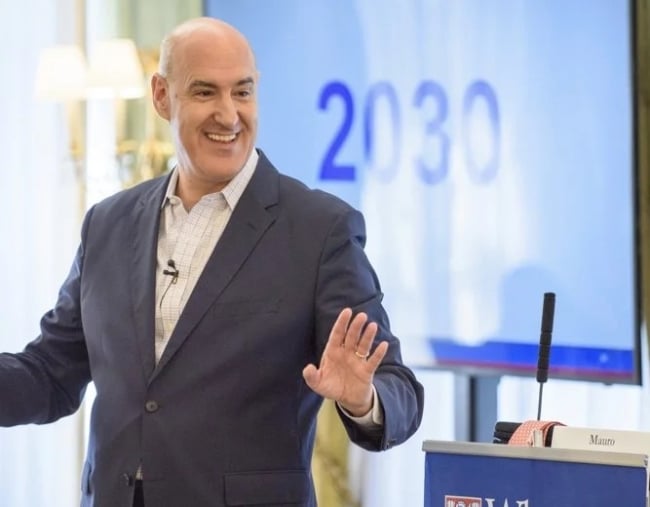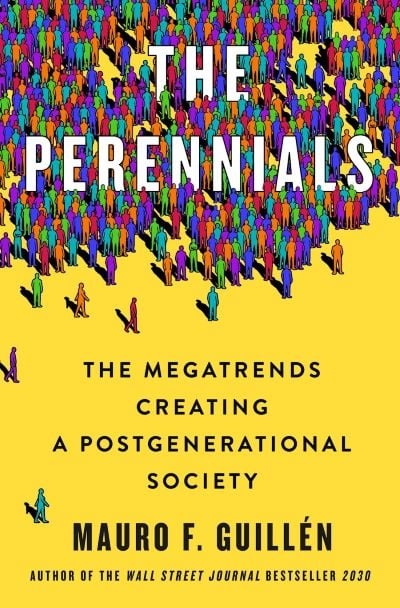You have /5 articles left.
Sign up for a free account or log in.

Mauro F. Guillén
University of Pennsylvania
What would higher education look like in a world where true lifelong learning—people engaging in education or training at many points throughout their lives—was the norm?
A recent episode of Inside Higher Ed’s The Key podcast explored that theme in a conversation with Mauro F. Guillén, author of The Perennials: The Megatrends Creating a Post-Generational Society (Macmillan, 2023) and the William H. Wurster Professor of Multinational Management at the University of Pennsylvania’s Wharton School.
The Perennials isn’t a higher ed book per se. It’s about larger social and societal changes that are influencing how we work, learn and live. But the trends it describes—people living longer and healthier lives, and technological changes that shorten the half-life of our knowledge and skills—have huge implications for institutions and workers alike.
A lightly edited transcript of the conversation follows.
Inside Higher Ed: What are “perennials” and how do you define the term “post-generational society” in your subtitle?
Guillén: Perennials are people who don’t think and or act their age. They are people who can go into learning mode or into working mode interchangeably, not according to their age at that moment in their lives. And the post-generational society is a recognition that we are not really people who belong to generations, we are ageless, and we can do different kinds of things at different ages without having to pay tribute to the stereotypes that we have been for too long abiding to.

Inside Higher Ed: Can you go back and tell us how those stereotypes got set in the first place?
Guillén: One hundred and forty years ago, two big innovations came out of Europe. The first one was that people were required to go to school—universal schooling. The second thing was that, first in Germany, industrial workers were promised a pension after a certain age. When those two innovations came into being, that divided up our lives into four different stages: First we would play; then we would go to school; then we would work; and finally we would be in retirement. That is a kind of rigid-stage living that the perennial mindset, and the post-generational society, is supposed to change.
Inside Higher Ed: How far along the continuum are we toward a post-generational society? Is this already clearly in motion or pretty prospective?
Guillén: We are moving very slowly toward that. We’re only at the beginning of that transition. For example, lifelong learning is a very recent phenomenon. In the United States, about 30 percent of the population above the age of 20 is now engaged in some type of learning, most of them online. Things have changed over the last 10 or 15 years, but it’s still a relatively small proportion of the entire population who is really doing that.
And the same goes for transitions from work to retirement and back. We have significant numbers of people who go into retirement and then realize “this is not for me,” so they go back to work. So we are seeing the beginnings of this transition, but there’s a long road ahead.
Inside Higher Ed: What trends and forces are bringing about the need to move in the direction you envision?
Guillén: One of them is that we live longer than in the past. But we not only live longer, we also stay in good mental and physical shape much longer than in the past. This concept that somebody who turns 60 is already an old person is from the distant past. It’s no longer the situation today. Somebody in their 70s or 80s is a totally different person from somebody of the same age 50 or 60 years ago.
The fact that we’re living longer, that we stay healthy longer, means that we have more years to not only enjoy life, but also to work and to pursue different careers. People are going to start by being something and working in some area, and then they’ll switch because their preferences shift. In the United States, we’ve never had so many people in medical school while in their 40s. It’s astounding. This is wonderful, right?
The other big trend we have to keep in mind is technology. The biggest impact of technology on our lives right now is that it makes whatever skills we have obsolete very fast. As individuals, we have to reinvent ourselves several times, because we learn something, and then new technologies make that knowledge obsolete or antiquated.
Inside Higher Ed: Some of this is already happening, of course, but is it still a long ways away from a post-generational society. What kind of time frame do you see this unfolding over? Is it decades or years?
Guillén: It’s going to be much less than decades, probably 10 to 15 years. Some organizations are changing very fast. Others are changing very slowly, especially universities like my own, the University of Pennsylvania, where we continue to do what universities have done for the longest time: First, we classify people into age groups and then we offer them different kinds of degrees. We have undergraduates, we have graduate students, we have executives, and so on.
Digital platforms are doing the opposite. They’re not classifying people into age groups. They’re bringing learners from different stages of life into the same platform, and they’re learning together. So some organizations are moving very quickly toward this future that I am envisioning, and others are moving more slowly. The same goes for companies. Some younger firms, especially technology firms, they’re already telling their employees, “You have to be a lifelong learner.” Other more established companies, larger companies, whenever an employee turns 50 years old, they start to look for ways to get rid of that person. The organizations that are changing quickly are going to be the pioneers in all of this.
Inside Higher Ed: The scenario you described is essentially an argument for the need for the embrace of lifelong learning. There’s been a lot of rhetoric over the last five to 10 years about the need for institutions to provide lifelong learning, but a lot more words than action and changes in behavior as I look at the landscape. Thinking about the great variety of institutions in the higher ed landscape, what are the most significant ways you would envision institutions changing to drive in this direction, as opposed to dragging their feet? What are the changes that are required for an institution to be well-positioned for this trend?
Guillén: Human beings are learners. But for 140 years, we’ve been told that there’s only a few years in our lives during which we’re supposed to learn—when we’re young. And then you’re supposed to work. Most Americans have a job they hate, but we’re nonetheless told, “Keep on working because you need to make some money. And save money, because you will get your reward at the end, at retirement.” That model is completely at odds with human nature because we are learners by definition.
So what is standing in the way? The obstacles are us. It’s a mindset that we have inherited from the past—those assumptions that we only learn when we’re young, and then we work, hoping that one day we will retire and we will be able to enjoy life. That is the single biggest obstacle—it’s in our minds, it’s in the culture, and it’s in the kinds of policies that both the government and major organizations, especially companies, have been using for the longest time.
Inside Higher Ed: With social movements like this, what tends to change first? I’m guessing that individual behavior starts to change before institutions do, since we know institutions are pretty small-c conservative when it comes to adapting what they do.
Guillén: Exactly, there’s a lot of inertia. But there’s inertia both on the part of individuals and on the part of organizations such as companies or governments. History tells us that what happens, invariably, is that you will get a few individuals, and you will get a few companies or governments, to switch gears. They will see the light, and they’re going to be much more effective at whatever they do, because the system that I’m suggesting will lead to higher productivity and more creativity. Then the dynamic of competition in the market—among governments, among companies—that’s going to do the rest of the job. Once the pioneering companies show that there is a better way, then everybody else will have no option but to follow suit because of competition in the market. The dynamic of the market is just too powerful. Nobody can go against it.
Inside Higher Ed: There are a set of institutions in higher education that have embraced this idea that learning happens across a lifetime—Western Governors University, Southern New Hampshire University—National University in California. They’re very large, heavily online institutions that have adapted the way they provide their learning and made a bunch of changes so they can serve people who are currently working and trying to change their careers and have average ages in the 30s as opposed to 18 to 20. Some of those places have gotten quite large, and those might be those early movers in this realm that you were describing.
To pivot a bit, there’s a fairly destructive tendency to position education and training as in opposition—you either come to a campus for four years and engage in studies that are mostly about learning and only secondarily about preparing you for a job, versus a much more vocational orientation. How does this shift you’re talking about, where people are learning throughout their lives, for shorter periods at a stretch or without leaving the workforce at all, affect that binary approach?
Guillén: The key characteristic of most higher education institutions is that they’re very rigid. They only offer one way of learning, and it’s very intensive—you have to be there for a number of years. They don’t really contemplate this other idea in which you want to be a learner throughout your life, maybe take off a couple of weeks a year to go back into learning mode. But companies these days are trying very hard to remain competitive in this knowledge economy. Having employees who are really, really good at what they do is key. But you cannot hope that they will learn everything they will need for the rest of their lives by age 25. So companies are also demanding this new flexibility and adaptability on the part of their employees. But most prominent education institutions don’t offer solutions to that, it’s mostly digital platforms that are offering this kind of lifelong learning as opposed to the traditional format.
Inside Higher Ed: The platforms you mentioned as pioneering in this space, the Courseras and edXs of the world, were built to a large extent using educational content provided by the traditional institutions that are lagging. The institutions are playing in that space through those platforms, as opposed to on their own. Do you see an opportunity, or should there be strategies for individual institutions to be providers of lifelong learning themselves? And if so, what would that look like? What kinds of changes would be required at a place that is operated in that traditional sphere?
Guillén: What I see is experimentation. You have preexisting platforms, such as LinkedIn, launching LinkedIn Learning. You have platforms [like Coursera] which essentially work with universities or with faculty at universities. We see all of these different kinds of experiments and a lot of trial by error. We haven’t yet figured out what is the best way to organize lifelong learning. We are in this phase in which you have a lot of disruption. A lot of different kinds of entrepreneurial ventures are being launched. We still don’t know which are going to actually work well.
You always go through this period where different kinds of people try out different kinds of things, and eventually the dynamic of the competitive market will select the things that work best. This revolution that we’re going through, where you see new experiments in education being launched, will have a very positive impact because people with different learning styles and preferences will naturally gravitate toward certain providers of lifelong education. That is the beauty of the market. Some of [the educational offerings] will be really good, others not so good. The market will help us eliminate those that are not good, and those that are really good, innovative, will grow.
Inside Higher Ed: When there is talk of disruption, that usually means some places adapt, and some don’t. When I look at the challenges facing the 3,000 to 4,000 colleges and universities, we’re about to enter a period where the number of “traditional-age” students (to use the old framing of people at different stages of life) is about to shrink. The best opportunity for institutions is doing what you’re talking about: recognizing that there are learners at different ages and stages, who can be the consumers of what colleges offer if they change their offerings and change their delivery models. Do you believe there will be significant loss in the number of providers there will be?
Guillén: Of course. The mechanism of the market will eliminate those who are not offering what people want. And let me be clear: a lot of educators, perhaps including myself, will lose their jobs. For me as an educator right now, one of the big priorities for me is to learn these new technologies. Because I know that’s the future. And if I don’t, then I would deserve to lose my job. New educators, new teachers are going to do better than others, and they’re going to have great jobs.
That’s how innovation works—the economist Joseph Schumpeter once said it’s all about creative destruction. You have creativity, you have innovation, that necessarily destroys at the same time that it creates. And it will happen in the education sector, which has been sheltered from this kind of competition and disruption for too long.
Inside Higher Ed: Will there continue to be a role for physical campuses and spaces?
Guillén: People will still want to have a life-transforming experience when they are 16, 17, 18 years old. However, the campus is not just going to be a physical space. There will be an intersection of physical space, also remote learning, and perhaps also the metaverse. Those things are going to be converging, and students, even when on campus, are going to have a three-dimensional experience, immersive experiences. And that future is going to bring us better learning outcomes, which—I completely believe that immersive learning is so much better than solutions.
Inside Higher Ed: We talked about disruption and what might be lost. I assume this vision, if and when it comes to pass, will actually result in expansion of learning opportunities to more people. Do you envision the amount of learning to possibly be exponentially larger, because people will be doing it throughout their lives?
Guillén: Yes, but most importantly, the learning will be adjusted to the needs of the moment. The fundamental problem with that the educational system today is that we’re teaching students today the skills we think they’re going to need for the next 40 years. That would be OK if nothing changed. But when we know things are changing from one day to the next, how can we possibly come up with a curriculum to last 40 years? We need an educational system and a curriculum that is so much more flexible, a curriculum that essentially changes with the times in real time.
We need more immersion, we need more experiential learning. What I hope your listeners will grasp is that new technologies for learning are not inferior to the traditional face-to-face classroom. They have the potential to give us educational opportunities that are far better. That’s why we need more experimentation, more trial and error.









